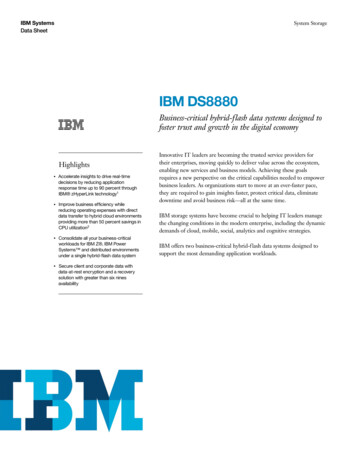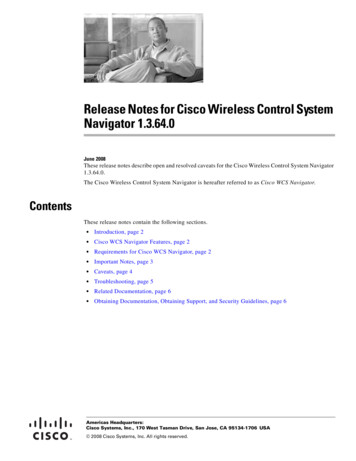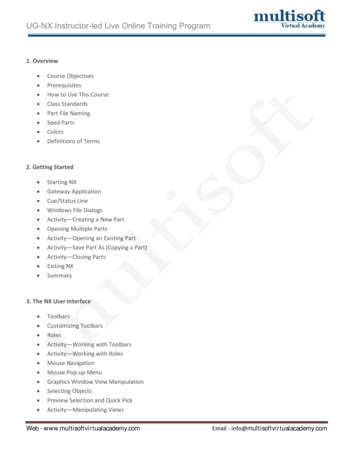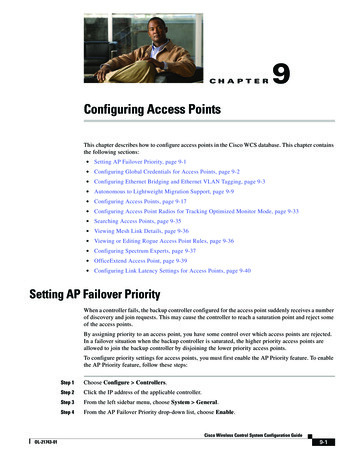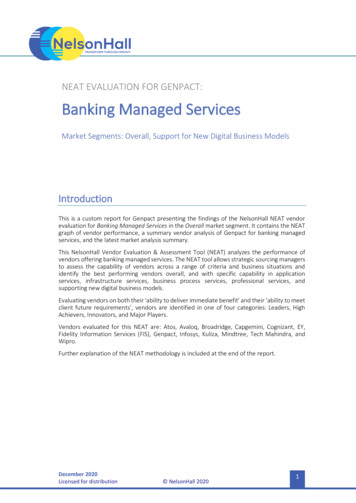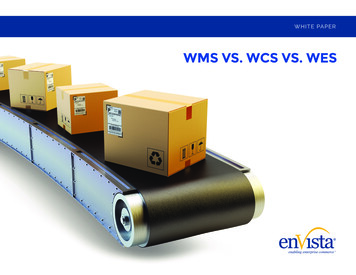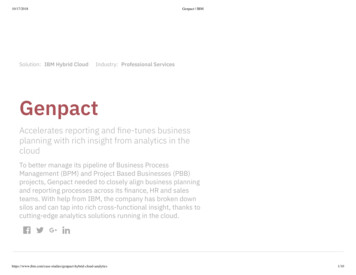
Transcription
10/17/2018Solution: IBM Hybrid CloudGenpact IBMIndustry: Professional ServicesGenpactAccelerates reporting and fine-tunes businessplanning with rich insight from analytics in thecloudTo better manage its pipeline of Business ProcessManagement (BPM) and Project Based Businesses (PBB)projects, Genpact needed to closely align business planningand reporting processes across its finance, HR and salesteams. With help from IBM, the company has broken downsilos and can tap into rich cross-functional insight, thanks tocutting-edge analytics solutions running in the cloud. oud-analytics1/10
10/17/2018Genpact IBMBusiness challengeRunning a large consultancy requires careful allocation of time, skills and otherresources. How could Genpact ensure that its financial and operational planningand reporting processes were up to the task?TransformationGenpact consolidated its departmental data marts into a single digitized cloudbased analytics platform built on IBM Db2 Warehouse on Cloud, IBM Cognos Analytics, IBM InfoSphere Data Stage and IBM Planning Analytics.Results2x faster2x faster35% reductionbusiness planning andbudgeting processesmonthly close andmanagementreporting cyclein operational costsby moving to IBMCloudBusiness challenge id-cloud-analytics2/10
10/17/2018Genpact IBMDramatic growthGenpact has carved out a niche in helping clients shape digital transformationjourneys to gain competitive advantage. To design and deliver eachtransformation on time and on budget, Genpact must ensure that it has the rightpeople with the right skills available at every moment during the project.To succeed in this high-pressure environment, the company’s financial andoperational planning need to be accurate, and its decision-makers needcontinuous insight into both current engagements and the future pipeline.Transformation initiatives often involve state-of-the-art technologies that requirespecialized expertise, so ensuring that the right resources are available is aconstant challenge—especially at Genpact’s scale. The company is engaged inhundreds of multi-year projects at any given time, and has more than 78,000people working across 70 locations in 16 countries.Vimal Dev, the company’s Vice President – IT, Global Enterprise ApplicationsLeader, explains: “To better plan our finances and operations, we needed aclearer view of our pipeline, revenue and expenditure. The challenge was that thedata we wanted was spread across departmental silos, so performing any crossfunctional analysis was complex and time-consuming.“To give an example, if we wanted to analyze the profitability of a given project,we would need to gather and combine data from sales, HR and finance. Eachdepartment maintained its own on-premise data warehouse, and it often tooktime just to get hold of the data and ensure that we were getting accurate,consistent answers. In short, as an IT team, we were spending too much timejust keeping the lights on, when we wanted to be adding more value to npact-hybrid-cloud-analytics3/10
10/17/2018Genpact IBMWith the move to IBM Analytics in the IBM Cloud, we have 40 percent more time to“focuson working with the business to add value. Instead of asking ‘how do I make itwork?’, we ask ourselves ‘how do I make it better?’. It’s a quantum shift in mindset.”—Vimal Dev, Vice President – IT, Global Enterprise Applications Leader, GenpactTransformation storyTaking to the cloudGenpact undertook a comprehensive review of its IT landscape and corebusiness processes, including employee training, hiring, budgeting and more.The company decided that to break down silos, the best option was to engage asingle global provider to help it build a fully centralized data warehouse, dataintegration and analytics platform. For maximum flexibility and scalability,Genpact also decided to deploy this entire new technology stack in the cloud.Vimal Dev explains: “The cloud enables us to hand off low-level tasks such asserver administration and IT capacity planning to a vendor, so that our own ITpersonnel can focus on strategic projects that add value to the business. IBMwas a natural choice of partner, as it was one of very few vendors that was ableto provide an end-to-end platform in the cloud.”Genpact became an early adopter of IBM Cognos Analytics on Cloud, whichgenerates intuitive, interactive reports and dashboards. Soon t-hybrid-cloud-analytics4/10
10/17/2018Genpact IBMGenpact also upgraded from its on-premise IBM Cognos TM1 solution to IBMPlanning Analytics on Cloud, to support budgeting and forecasting.To integrate data from diverse functions such as sales, finance and HR, Genpactmoved from its existing Oracle and Informatica solutions, and established acentral data warehouse built on IBM Db2 Warehouse on Cloud. To transfer datafrom the operational systems to the data warehouse for analysis, the companyrelies on ETL processes powered by IBM InfoSphere DataStage on Cloud.“We were one of the first companies to put our entire analytics stack on cloud, sounderstandably we hit some challenges along the way,” recalls Vimal Dev. “Forexample, we were among the first IBM clients to deploy Db2 Warehouse onCloud on such a large scale, and at that time, the product was at an early stage ofmaturity.“What impressed us was that whenever we hit obstacles, IBM worked closelywith us to resolve them, and the project has been a valuable learning experienceboth for us and for IBM. We have built strong relationships with the IBM productteams in particular: whenever we reported an issue, they were almost alwaysable to fix it in the next release, and often found a workaround for us to use in themeantime.“Despite those initial teething problems, the project has been a huge success,and the software is now robust and stable. Results have exceeded ourexpectations in several areas, and we have been able to bring more areas of thebusiness into the cloud than we initially anticipated.”Today, the cloud-based IBM Analytics solutions help teams across Genpactperform activities such as planning, budgeting, monthly closing, sales planning,and monitoring the employee lifecycle. In each process, the teams can -cloud-analytics5/10
10/17/2018Genpact IBManalyses on-the-fly to guide their decision-making, drawing on data frommultiple departments to paint a full picture of the company’s financial positionand operational status.Vimal Dev remarks: “Around 2,000 employees consume reports generated byCognos Analytics from data in our central data warehouse. One of the biggestadvantages of moving to the IBM Analytics solutions on IBM Cloud has been therise in self-service reporting; whereas before, people depended on the IT team togenerate reports, now around 200 power users on the business side can accessoperational data and run their own analyses, without IT as a bottleneck. Toensure insight is spread to all corners of the business, we have embedded powerusers in each department.”reduced our on-premise hardware footprint, and we have been“Moving to cloud hasableto cut IT operational costs by 35 percent.”—Vimal Dev, Vice President – IT, Global Enterprise Applications Leader, GenpactResults storySparking better decision-makingBy consolidating on a single data warehouse and adopting cutting-edge IBMAnalytics solutions, Genpact has transformed its analytics, reporting andplanning processes. The company has cut its planning cycle in half, and cancomplete monthly closing twice as fast as before. In addition, because rid-cloud-analytics6/10
10/17/2018Genpact IBMfigures are now imported from the ERP system in four hours rather than eight,employees can run reports and base decisions on more recent data.The move to cloud has also sparked major benefits for Genpact’s IT team, asVimal Dev explains: “A few years ago, my team probably spent around half theirtime just keeping everything running – now it’s around 10 percent. With the moveto IBM Analytics in the IBM Cloud, we have 40 percent more time to focus onworking with the business to add value. Instead of asking ‘how do I make itwork?’, we ask ourselves ‘how do I make it better?’. It’s a quantum shift inmindset.”“Another advantage of cloud is that it’s much easier to stay on the latest softwarerelease and take advantage of up-and-coming technologies. For example, thelatest version of Cognos Analytics features much better visualizations, is moreuser-friendly, and offers better support for self-service reporting. We havemonthly meetings to discuss new features and how we can use them to ouradvantage.“Moving to cloud has reduced our on-premise hardware footprint, and we havebeen able to cut IT operational costs by 35 percent. At the same time, we haveescaped the capacity limitations of the on-premise model, and can scale ourcloud environment up to run more reports in parallel when we need to.”In future, Genpact plans to extend its use of cross-functional analyses and divedeeper into forecasting, for example creating short-term revenue forecasts usingIBM SPSS software. The company is also exploring potential use-cases formachine learning and data science.Vimal Dev concludes: “Demand for analytics tends to increase exponentially, sowe can always expect to be faced with new demands. With IBM hybrid-cloud-analytics7/10
10/17/2018Genpact IBMsolutions on IBM Cloud, we are in a strong position to keep our capabilities in linewith users’ expectations and deliver real value to the business.”About GenpactGenpact (NYSE: G) is a global professional services firm that makes businesstransformation real. The company drives digital-led innovation and digitallyenabled intelligent operations for its clients, guided by experience of runningthousands of processes for hundreds of Global Fortune 500 companies. FromNew York to New Delhi and more than 16 countries in between, Genpact has theend-to-end expertise to connect every dot, reimagine every process, andreinvent companies’ ways of working. Transformation happens here.Solution components Cognos Analytics on CloudDataStage on CloudDb2 Warehouse on CloudPlanning hybrid-cloud-analytics8/10
10/17/2018Genpact IBMTake the next stepIBM Analytics offers one of the world's deepest and broadest analytics platform,domain and industry solutions that deliver new value to businesses,governments and individuals. For more information about how IBM Analyticshelps to transform industries and professions with data, visit ibm.com/analytics.Follow us on Twitter at @IBMAnalytics, on our blog at ibmbigdatahub.com andjoin the conversation #IBMAnalytics.View more client stories or learn more about IBM AnalyticsPrint Copyright IBM Corporation 2018. 1 New Orchard Road, Armonk, New York 10504-1722 United States. Produced in the UnitedStates of America, May 2018.IBM, the IBM logo, ibm.com, Cognos, DataStage, Db2, IBM Cloud, InfoSphere, and SPSS are trademarks of International BusinessMachines Corp., registered in many jurisdictions worldwide. Other product and service names might be trademarks of IBM or othercompanies. A current list of IBM trademarks is available on the web at “Copyright and trademark information” atibm.com/legal/copytrade.shtml.Not all offerings are available in every country in which IBM hybrid-cloud-analytics9/10
10/17/2018Genpact IBMThe performance data and client examples cited are presented for illustrative purposes only. Actual performance results may varydepending on specific configurations and operating conditions.All client examples cited or described are presented as illustrations of the manner in which some clients have used IBM products andthe results they may have achieved. Actual environmental costs and performance characteristics will vary depending on individualclient configurations and conditions. Contact IBM to see what we can do for you.The client is responsible for ensuring compliance with laws and regulations applicable to it. IBM does not provide legal advice orrepresent or warrant that its services or products will ensure that the client is in compliance with any law or t-hybrid-cloud-analytics10/10
Genpact became an early adopter of IBM Cognos Analytics on Cloud, which generates intuitive, interactive reports and dashboards. Soon afterwards, With the move to IBM Analy tics in the IBM Cl oud, we have 40 percent more time to focus on working with the business to add value. Instead of asking 'how do I make it
